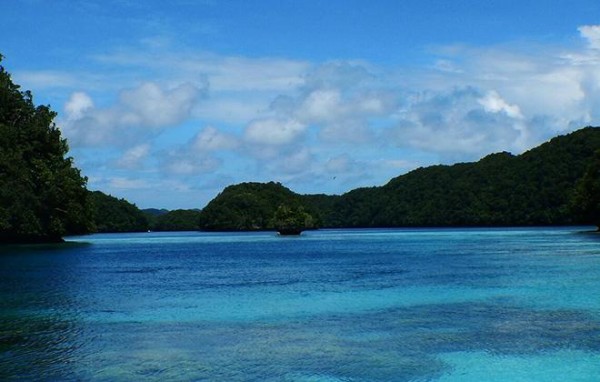Published in the Ocean Watch column, Honolulu Star-Advertiser © Susan Scott
November 9, 2015
KOROR, Palau >> Because I flew to this island nation directly from Australias Great Barrier Reef, my expectations were high. And sure enough, before I even got my feet wet, I saw an animal that moved me to tears.
Standing on the concrete wall of a boat ramp where I was about to take my first plunge in Palau waters was a Pacific golden plover.
Hello, kolea! These plovers arent the same individuals we see in Hawaii, but theyre the same species. Palauans called them derariik.
 The water between the islands of the Republic of Palau
The water between the islands of the Republic of Palau
is full of coral, marine mammals and other wildlife.
©Susan Scott
Because plovers and other migratory shorebirds nest in the Arctic, the ones that winter here make longer annual round-trip flights than our kolea. The 10-inch-long birds cant store enough fat for such long journeys if they did they couldnt fly.
The plovers that winter here and farther south make refueling stops in the rice fields of Japan and possibly other parts of Asia. To see that graceful bird performing its familiar ballet at the Palau shoreline gave me such joy that I thought, If I see nothing else here, Ill be happy. Of course, I know that during my two weeks here I will see countless other wonders. Palau was named a UNESCO World Heritage Site in 2012 for good reason.
The Republic of Palau consists of 586 islands that lie about 400 miles north of the equator, similar to the latitude of Palmyra Atoll. Situated in the western part of Micronesia, Palau is roughly between and a bit south of the Philippines and Guam.
Because the total land area of Palaus islands is 176 square miles, most of Palau consists of water. This is no ordinary water.
More than 600 species of hard and soft corals grow here between green toadstool-shape islands. They are so eye-popping that one of my snorkeling companions said she felt as if she were in a Disney movie.
A surrounding barrier reef protects the inner islands from offshore waves, and three oceanic currents converge here, supporting a vast variety of marine life. These combinations make Palau a diving, kayaking and snorkeling paradise.
Palauans are rightly proud of the unique beauty and nature of their nation, and work to protect it. Palau was the first country, in 2009, to create a shark sanctuary, and in 2010 the government made Palaus waters a marine mammal preserve.
Fishing is banned in large areas, licensed guides are mandatory and park fees go to maintaining tour facilities. A wildlife preserve called the 70 Islands is off-limits to everyone, giving turtles, dugongs and other marine animals a human-free haven.
When I returned from my first amazing snorkeling excursion here, my plover was still dancing on the wall. I take it as a sign of great things to come.